| April 14, 2018
God’s Power Tourer
Kawasaki has released the most mental bike in its history with side bags. Because, you know, you need those when breaking the Cannonball record.
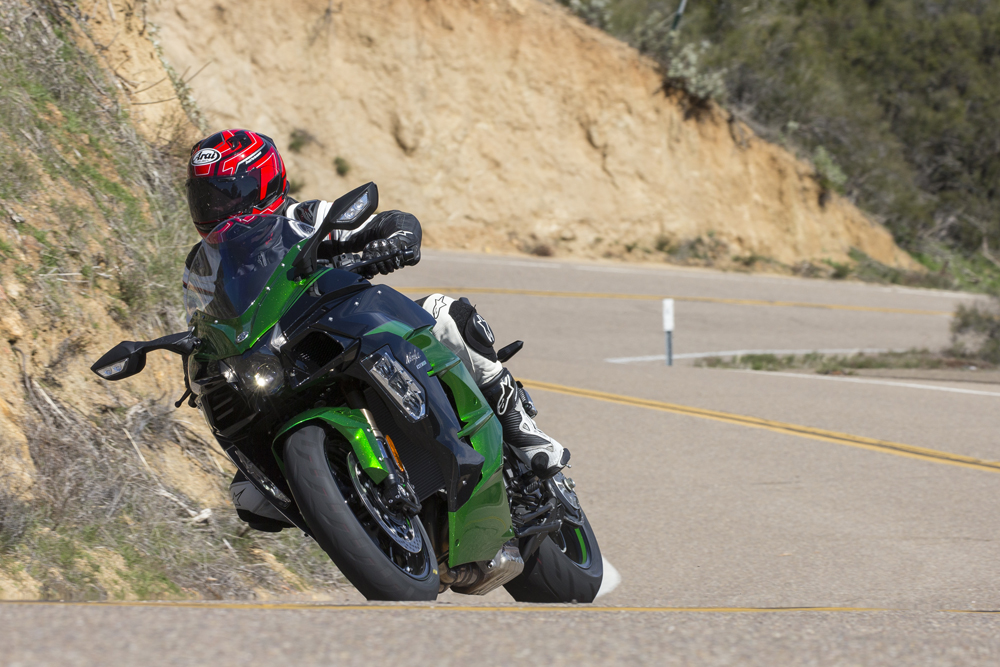 There’s nary a better sounding or for that matter, faster ride for your next tour.
There’s nary a better sounding or for that matter, faster ride for your next tour.
The sunshine breaks through the morning fog, its intense beam reflecting off the uber-exotic automobiles littering the parking lot. Each a different make, the cars represent premium performance, comfort, and style—and all reflective of their owner’s financial status. These vehicles weren’t designed to skimp in one area to excel in another, they are the best of the best.
On the far end of the lot, a crowd is gathering around a space. Considering the rest of the vehicles here, it must be something special. Stepping towards the bunch, it’s obvious this machine is unlike the rest. The engine fires, its high-pitched ring followed closely by a unique chirp of a supercharger. Oh, and it’s not a car we’re talking about, it’s a motorcycle. Special? Yeah, definitely.
Behold, the Ninja H2 SX SE.
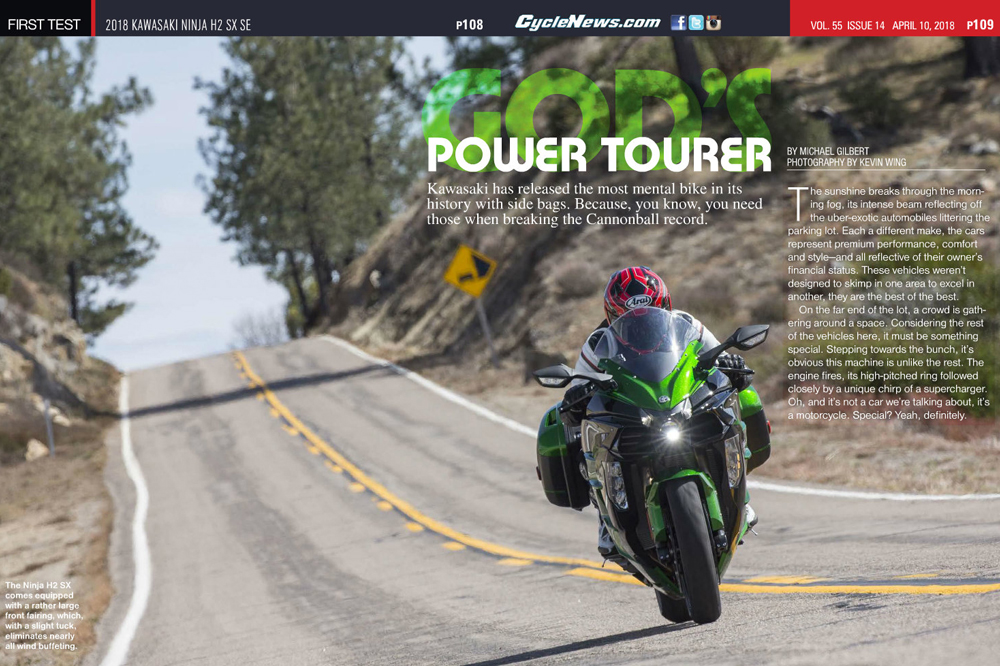
By Michael Gilbert
Photography by Kevin Wing
In creating the Ninja H2 SX, Kawasaki’s idea was simple: Deliver the same supercharged performance as the rest of the H2 hypersport family, but in a package worthy of using for everyday riding. This meant Team Green looked to the rest of its lineups, pulling the best qualities from each and combining them to forge an all-new motorcycle. The H2 SX isn’t another hyperbike, nor a superbike, or even a sport tourer. It’s something different, something great.
The basis of the Ninja H2 SX is the same inline-four cylinder, 998cc supercharged engine that powered the exotic Ninja H2 and H2R machines released back in 2015, though it has been redesigned specifically for the SX in order to boost low-to-mid range performance and improve fuel efficiency.
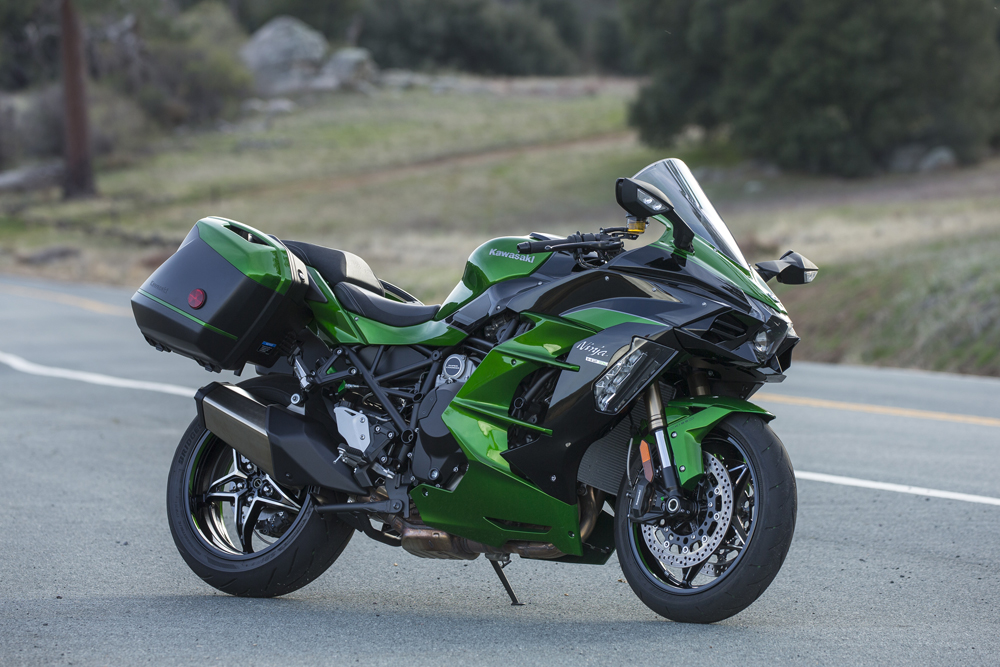 What’s the difference between the standard and the SE? The SE gets a larger windscreen, heated grips, upgraded seat and wheels, launch control, quick-shifter, full color LCD display and LED corning lights.
What’s the difference between the standard and the SE? The SE gets a larger windscreen, heated grips, upgraded seat and wheels, launch control, quick-shifter, full color LCD display and LED corning lights.
To achieve this, engineers boosted the compression to 11.2:1 (from 8.5:1 on the H2 and H2R) with a newly designed piston, narrowed the engine’s intake and exhaust ports, reduced the throttle body sizes from 50mm to 40mm, as well as shortened the cam timing.
The exhaust system’s head pipes and connector pipes have also shrunk in size in comparison to the H2, and so did the silencer. The goal here isn’t to take away performance, but relocate the power, making it a well-balanced, yet viscous street weapon instead of an all-out missile.
Engineers also spent time revising the supercharger, which uses Kawasaki Gas Turbine and Aerospace technology to minimize heat gain and better performance during street riding—including improved fuel economy and increased midrange power. The supercharger is planetary gear driven, and spins its 69mm impeller at 9.2 times the speed of the crankshaft. Due to its superb efficiency, the need for an intercooler is eliminated. An added bonus is a sound hole in the intake duct has been placed to let the rider enjoy the supercharger’s unique chirping under deceleration.
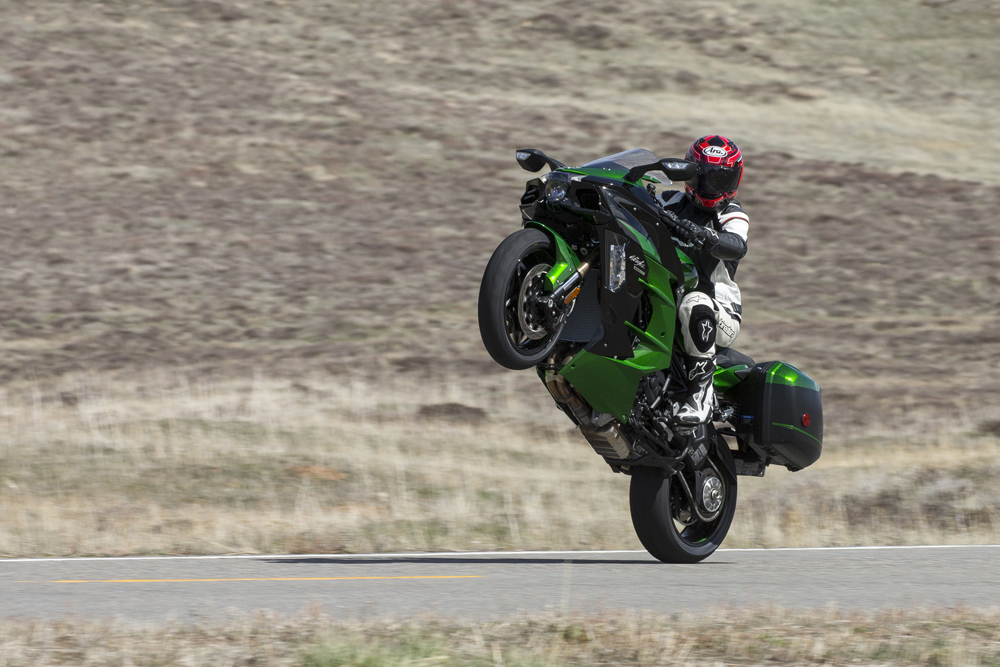 Yes, the H2 SX can still wheelie. The supercharged, 999cc inline-four is a riot on any road.
Yes, the H2 SX can still wheelie. The supercharged, 999cc inline-four is a riot on any road.
Keeping the Ninja H2 SX’s beastliness in check is a whole host of electronic rider aids, all of which are selectable via the full LCD display that lies aside the analog tachometer.
A Bosch five-axis IMU (with a sixth yaw axis added through Kawasaki’s own proprietary software) and ride-by-wire throttle enhances the precision of the motorcycle’s KTRC (Kawasaki Traction Control) system as well as the KIBS (Kawasaki Intelligent Braking System), which acts as a corning ABS unit.
The KTRC is available in three modes aboard the SX—Mode One allowing lofting wheelies and little intervention against wheelspin, Mode Two slightly drawing back the rowdiness of the SX’s powerplant, and Mode Three being designed to handle wet or slippery conditions.
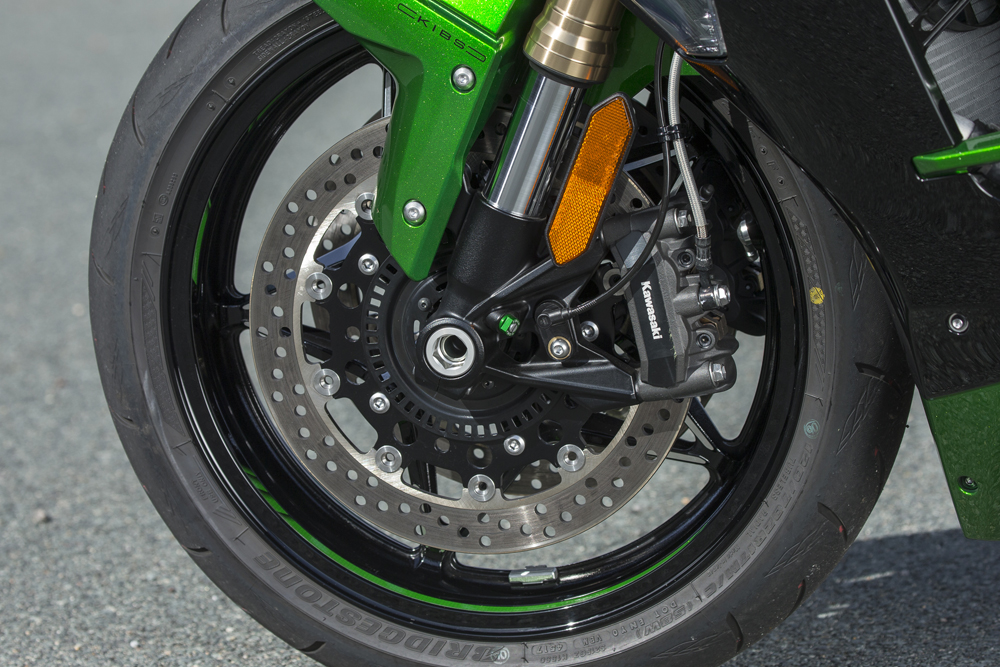 Bringing the H2 SX to a halt is a pair of four-piston calipers clamping to 320mm discs. ABS comes standard on both models.
Bringing the H2 SX to a halt is a pair of four-piston calipers clamping to 320mm discs. ABS comes standard on both models.
In its transition from hyperbike to everyday rider, the Ninja H2 SX’s chassis also got some significant changes. The motorcycle’s wheelbase is 30mm longer than that of its H2 siblings, thanks to the single-sided swingarm being extended by 15mm as well as the steering head being pushed out by another 15mm.
These changes—in addition to a slightly lower center of gravity due to the engine being titled forward another two degrees—help stabilize the SX’s chassis and eliminate the need for a steering damper. In addition, the chassis’ rigidity has also been increased to handle the added load of a passenger and optional hard luggage.
There’s two versions of Ninja H2 SX; the standard model priced at $19,000 and the upper-spec SE version at $22,000. The jump in cost between the two models is due to the number of premium features the SE gets, including a Launch Control mode, up and down quick-shifter, TFT color dashboard, LED cornering lights, and rims with machined spokes among other bits.
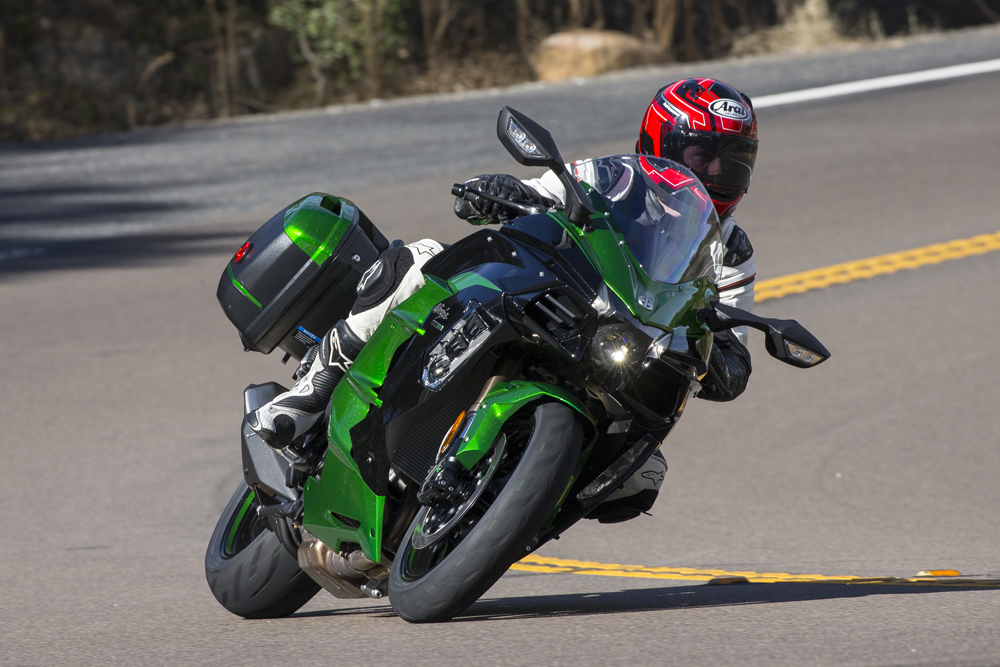 The Kawasaki Ninja H2 SX SE is a mean-looking machine. $22,000 is a considerable chunk of change for a motorcycle, but a quick look at the spec sheet will prove its worth.
The Kawasaki Ninja H2 SX SE is a mean-looking machine. $22,000 is a considerable chunk of change for a motorcycle, but a quick look at the spec sheet will prove its worth.
Master Blasting on the H2 SX SE
Kawasaki’s press launch for the Ninja H2 SX begins in Rancho Santa Fe, California, a place where high-end automobiles out-number the residents and money trees line the streets. Well, sort of. You get the point. Once out of town, Team Green has a 200-mile long route planned, with everything from highway stints to backroad twisties—aboard the up-spec SE model of course.
Opening the throttle on the H2 SX SE is damn impressive, period. Fast? Even more so than you might think, but its all-around capabilities that make it so remarkable.
Initial throttle response is soft, with power readily available around the 4500 rpm mark. Then comes a smooth transition from gentle delivery to arm-pulling acceleration as the tachometer needle climbs above 7000 rpm before quickly running into its limiter at 12,000.
Kawasaki’s work here impresses me. The broadness of the SX’s powerband means that the motorcycle will happily handle any sort of touring-type riding, while still harnessing the performance of its hyperbike siblings. It’ll get you to where you need to be in a hurry, but has no problem taking a leisurely cruise either.
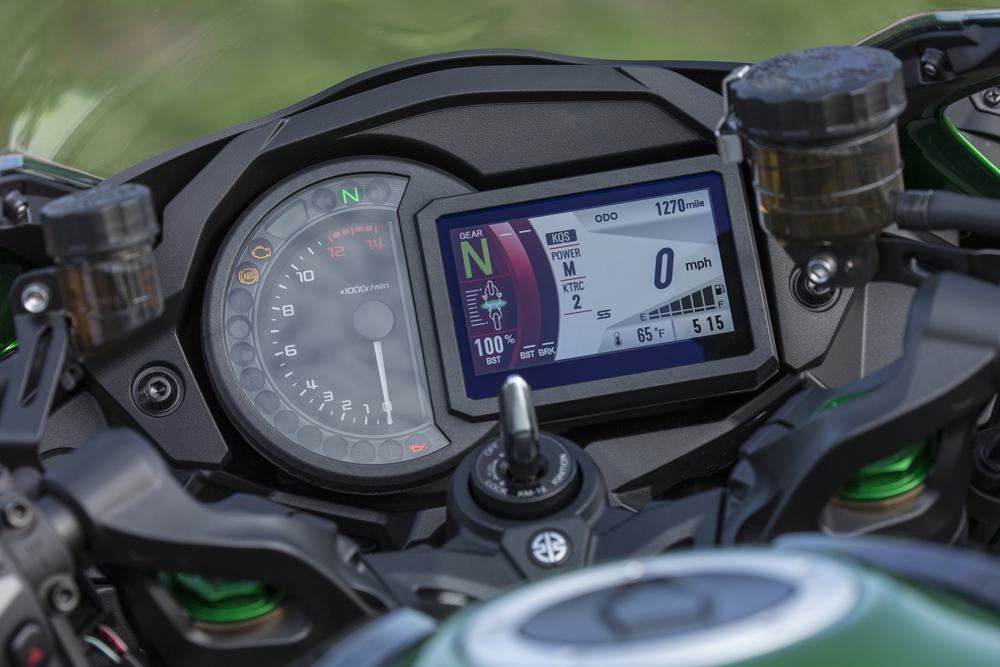 The colored TFT display sits alongside an analog tachometer. From here, you are able to adjust the various electronic rider aids equipped to the motorcycle.
The colored TFT display sits alongside an analog tachometer. From here, you are able to adjust the various electronic rider aids equipped to the motorcycle.
Team Green made bold claims about the H2 SX’s improved fuel efficiency, and our test ride only backed them up. It wasn’t unusual to see fuel averages reading upwards of 50 mpg while on the open road, meaning that on a laid-back ride, pulling about 180 miles out of a tank is entirely possible. Good luck with that, however. The SX’s sheer potential for speed makes it too easy to hammer on the throttle, which drops the fuel range quickly.
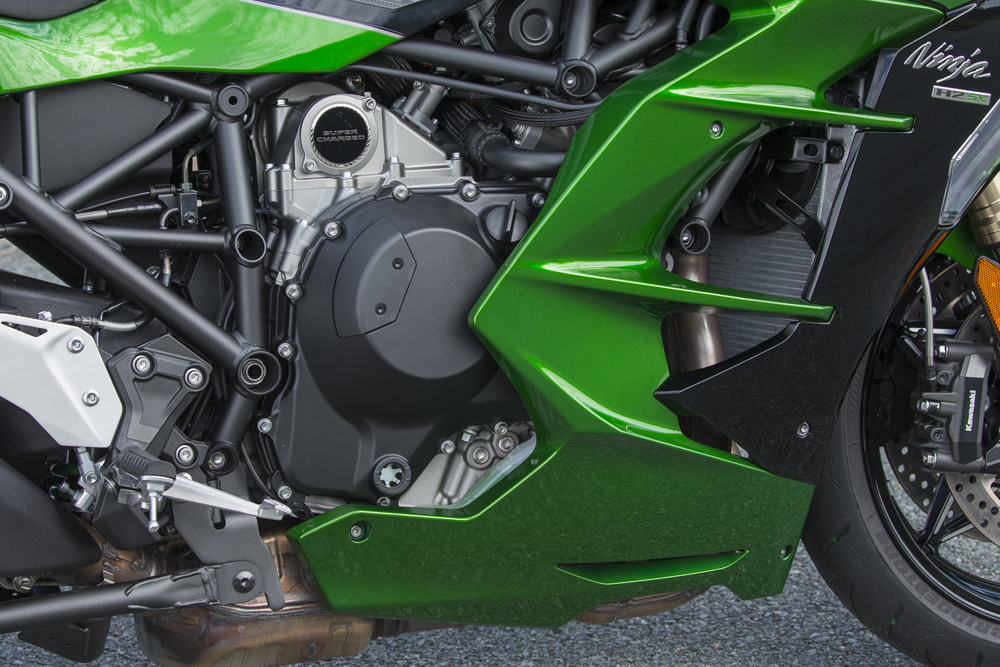 The heart of the Ninja H2 SX is a supercharged 999cc engine. Kawasaki put a large amount of effort into tuning its power characteristic to make it worthy of everyday riding.
The heart of the Ninja H2 SX is a supercharged 999cc engine. Kawasaki put a large amount of effort into tuning its power characteristic to make it worthy of everyday riding.
The new ride-by-wire throttle and electronics packages makes for a rather un-eventful ride, which is a compliment to the precision of the systems. With KTRC set in Mode One, there were only hints of noticeable intervention, and even those came with some serious greediness of the throttle. The bi-directional quick-shifter provides seamless gear changes, especially making getting into corners quickly a thoughtless process. One of my only gripes about the SX is a very slightly abrupt throttle response at slow speeds, but switching to the Middle power mode (which softens the response and reduces total output to roughly 70 percent) cleared any issues.
Along with the updated chassis, Team Green fitted the SX with a set of fully adjustable 43mm KYB forks up front and fully adjustable rear shock out back, along with a new, more-progressive linkage. The result is a ride quality I’m comfortable saying is the best in the business. The package provides ample amounts of feel from both ends of the motorcycle at pace, while maintaining the ability to soak up harsh bumps or severe imperfections in the road surface. The Bridgestone Battlax S21 tires compliment the chassis, offering superb grip and feedback to the rider.
 The front end of the SX is fitted with a set of fully adjustable 43mm KYB forks, which provide tons of feel and support under any condition.
The front end of the SX is fitted with a set of fully adjustable 43mm KYB forks, which provide tons of feel and support under any condition.
Sport tourer? Well…
The Ninja H2 SX SE is a comfortable motorcycle. A large front fairing eliminates nearly all wind buffeting, and the ergonomics are far more comfortable than the typical sportbike.
The reach to the handlebars is relaxed and the getting your feet on the pegs won’t force a leg cramp either. And for being 573 pounds fully fueled, the SX carries its weight well, so much that I’d bet it can keep up with some “true” sportbikes in the twisties, no problem.
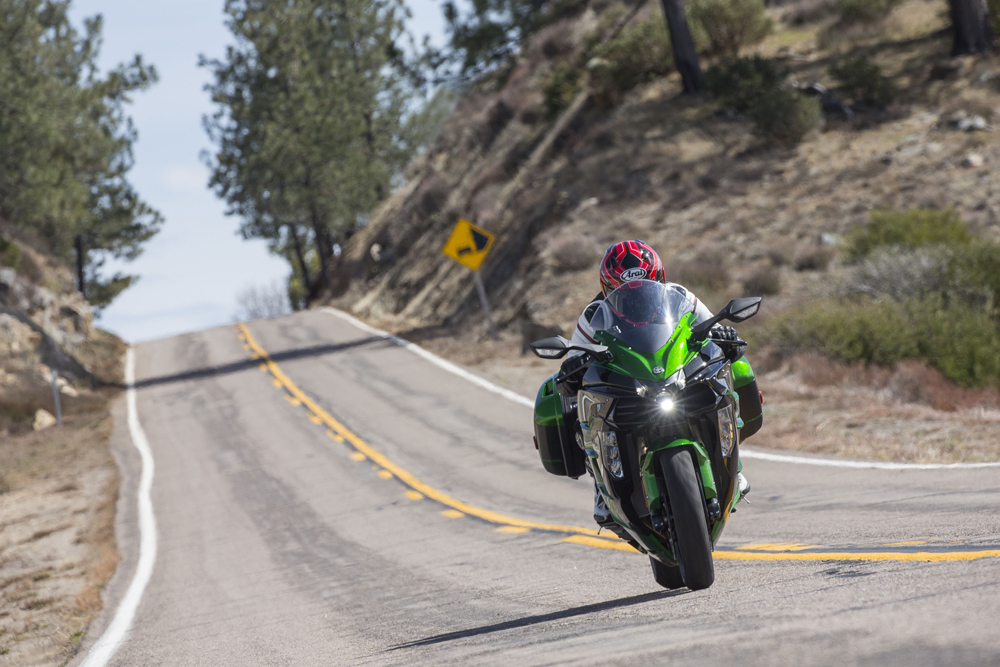 The Ninja H2 SX comes equipped with a rather large front fairing, which with a slight tuck, eliminates nearly all wind buffeting.
The Ninja H2 SX comes equipped with a rather large front fairing, which with a slight tuck, eliminates nearly all wind buffeting.
Calling the H2 SX a “sport tourer,” though, is a difficult thing to do. It lies somewhere in the middle ground between being an all-out sportbike and a big-mile sport tourer. The breaking point for me was right about the 200-mile mark, when fatigue began to set in. Kawasaki’s choice of seats for the SX proves to be uncomfortable for anything more than a few hours, and even with cruise control and a more-relaxed ergonomic set up, my wrists began aching as time went on. Team Green could make this motorcycle more comfortable as the miles pass, but that would likely take away from its true performance potential. The balance is a difficult thing to find.
 These switches located on the left handlebar allow the rider to toggle through various electronic settings, including KTRC settings, selectable Power Modes, and the Cruise Control function.
These switches located on the left handlebar allow the rider to toggle through various electronic settings, including KTRC settings, selectable Power Modes, and the Cruise Control function.
So, who is this motorcycle meant for? The Ninja H2 SX SE is the dream build for the older gentlemen that are still looking for pure sportbike performance, while wanting to be comfortable riding it for more than a few miles at a time. It’s downright fast, nimble on its feet, and comes with all the luxuries that make a long day on the bike enjoyable, rather than a chore.
Hell, if I had a considerable savings, I wouldn’t mind parking this next to any supercar on the lot.CN
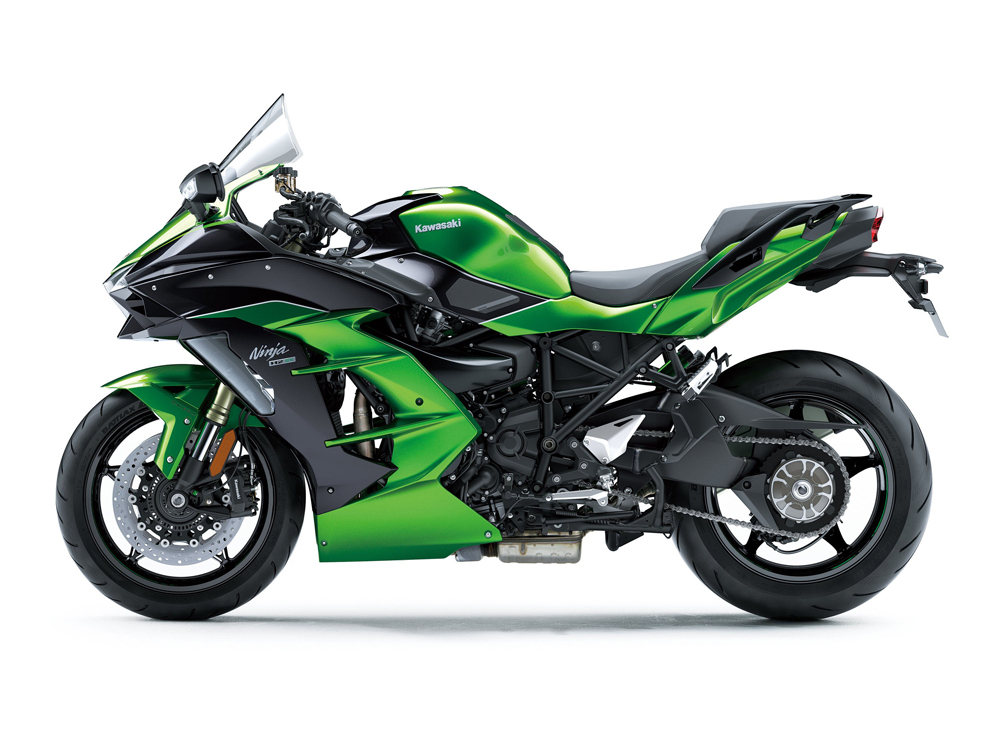
|
SPECIFICATIONS
|
|
|
2018 Kawasaki H2 SX and SE ($19,000, $22,000 SE)
|
|
Engine:
|
Liquid-cooled, 4-stroke, 4-cylinder, DOHC, 4-valve, supercharged
|
|
Displacement:
|
998cc
|
|
Bore x stroke:
|
76 x 55 mm
|
|
Compression ratio:
|
11.2:1
|
|
Clutch:
|
Wet multi-plate
|
|
Transmission:
|
6-speed
|
|
Chassis:
|
Trellis, high-tensile steel, with swingarm mounting plate
|
|
Front suspension:
|
43mm inverted, fully adjustable
|
|
Rear suspension:
|
Uni-Trak, gas-charged shock with piggyback reservoir, fully adjustable
|
|
Front wheel travel:
|
4.7 in.
|
|
Rear wheel travel:
|
5.5 in.
|
|
Front brake:
|
Dual radial-mount, opposed 4-piston monobloc calipers, dual semi-floating 320mm discs, KIBS ABS
|
|
Rear brake:
|
Opposed 2-piston calipers, single 250mm disc, KIBS ABS
|
|
Front tire:
|
120/70 ZR17 (58W)
|
|
Rear tire:
|
190/55 ZR17 (75W)
|
|
Rake:
|
24.7°
|
|
Wheelbase:
|
58.3 in.
|
|
Seat height:
|
32.9 in.
|
|
Fuel capacity:
|
5.0 gal.
|
|
Weight (wet, claimed):
|
573 lbs.
|
|
Color:
|
Metallic Carbon Gray/Metallic Matte Carbon Gray; Emerald Blazed Green/Metallic Diablo Black (SE)
|